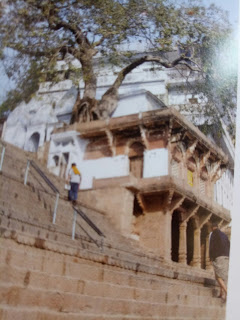Discovering Tulsidas in Tulsi Ghat
 |
| Tulsidas Ashram at Tulsi Ghat |
A fairly aggressive greets me with aggression as it jumps from the peepal tree. I become defensive and allows me to pass. In Tulsi Ghat, I spot the guesthouse of the Sankatmochan Foundation and the laboratory of the Swachh Ganga Foundation, which spearheads the cleanup of the river Ganga in Varanasi. For a house that is 400 years old, one would expect it to be fairly well-known. I ask for directions to the Tulsi Ashram and a man indicates the house with his index finger right across the street opposite the akhara (wrestling rink).
Walking into the white-coloured house through a vestibule like entrance, I take in my breath and stop as I tread carefully on the marble floored hall with an enclosed Hanuman idol smeared with vermillion placed under a golden umbrella. On the left is a statue of Goswami Tulsidas sitting in a meditative pose. Goswami Tulsidas, a medieval saint poet who adapted the Valmiki Ramayana into Awadhi from Sanskrit. He is credited to have popularised the Ramayana in North India. The ashram itself is quite bare, save for a few devotees offering their prayers.
A tunnel like staircase leads me to the first floor where Tulsidas lived and worked. On the first floor, the entire Ramcharitmanas prefaced with the Hanuman Chalisa, two of the saint's most well-known and highly revered works are inscribed on the bare but peeling walls. A dingy lock-up like windowless room has Tulsidasji's padukas (footwear), charpai (bed) and naav (boat) locked carefully. "No photography please," says a cringing voice as I take out my camera to click a picture. Startled, I turn around and meet Vishambar Nath Mishr ji, the current mahant (head) of the Tulsi Ashram.
I greet him with a namaste and "Jai Sri Rama" and he then asks me to sit on a mat on the floor. After reading the Hanuman Chalisa in entirety, he tells me that this 400 year old house has been maintained by mahants since Goswami Tulsidas attained mahasamadhi in 1623 at the age of 80. The mahants are nominated by the teacher according to the guru-shishya tradition. Vishambar ji is currently the 13th mahant of this house.
"Tulsidasji lived in this house around 400 years ago. Though this is just one of the many houses he lived in, this is where he lived the longest. The last four kandas (cantos) of the Ramcharitmanas from Kishkindha Kanda onwards were written here. Most of his day was spent on chanting the name of Rama," says Vishambar Nath Mishr ji, who is also a professor of Electronics Engineering at the Banaras Hindu University. He further adds that it was Tulsidas who popularised the worship of Hanuman in North India and established the Sankatmochan Temple. His faith in the Ramayana led him to popularise Ramlila performances in Varanasi. Today, the Ramlila of Ramnagar is patronised by the titular prince of Varanasi and is a month long affair.
"The scholars of Varanasi were unhappy with Tulsidas and accused him of defiling the sanctity of the Valmiki Ramayana by translating it to Awadhi. They challenged the worth of the Ramcharitmanas and placed it in the sanctum sanctorum of the Vishwanath Temple with a pile of the Vedas and other holy scriptures. In the morning, when they opened the door, the Ramcharitmanas was placed on top of the pile with the words "Satyam Shivam Sundaram" (Truth Godliness and Beauty) inscribed on it," he says. I realise that in India, there is no distinction betwen belief and devotion, fables and stories and people believe what they want to.
I decide to leave when the bells chime as the time for the Ganga Aarti at the neighbouring Assi Ghat nears. While waking up, Vishambar ji advises me, "Before you leave, stop and pay your respects to Rama. It is at the extreme right." I smile and do as he says. A divine sense of calm surrounds me and a few minutes later, he hands me over a copy of the Ramcharitmanas in Awadhi prefaced with the Hanuman Chalisa. As I quickly snake out through the vestibule like entrance, I realise the Ramayana and Rama are civilisational threads which bind India together. For many in Varanasi, Tulsidas, Rama and Hanuman are living Gods.


Comments